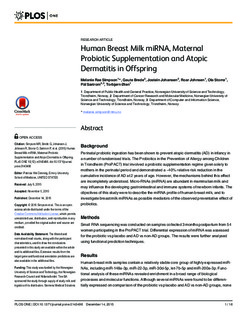| dc.contributor.author | Simpson, Melanie Rae | |
| dc.contributor.author | Brede, Gaute | |
| dc.contributor.author | Johansen, Jostein | |
| dc.contributor.author | Johnsen, Roar | |
| dc.contributor.author | Storrø, Ola | |
| dc.contributor.author | Sætrom, Pål | |
| dc.contributor.author | Øien, Torbjørn | |
| dc.date.accessioned | 2016-01-11T12:15:38Z | |
| dc.date.accessioned | 2016-03-09T14:32:04Z | |
| dc.date.available | 2016-01-11T12:15:38Z | |
| dc.date.available | 2016-03-09T14:32:04Z | |
| dc.date.issued | 2015 | |
| dc.identifier.citation | PLoS ONE 2015, 14(10) | nb_NO |
| dc.identifier.issn | 1932-6203 | |
| dc.identifier.uri | http://hdl.handle.net/11250/2381888 | |
| dc.description.abstract | Background: Perinatal probiotic ingestion has been shown to prevent atopic dermatitis (AD) in infancy in a number of randomised trials. The Probiotics in the Prevention of Allergy among Children in Trondheim (ProPACT) trial involved a probiotic supplementation regime given solely to mothers in the perinatal period and demonstrated a ~40% relative risk reduction in the cumulative incidence of AD at 2 years of age. However, the mechanisms behind this effect are incompletely understood. Micro-RNAs (miRNA) are abundant in mammalian milk and may influence the developing gastrointestinal and immune systems of newborn infants. The objectives of this study were to describe the miRNA profile of human breast milk, and to investigate breast milk miRNAs as possible mediators of the observed preventative effect of probiotics.
Methods: Small RNA sequencing was conducted on samples collected 3 months postpartum from 54 women participating in the ProPACT trial. Differential expression of miRNA was assessed for the probiotic vs placebo and AD vs non-AD groups. The results were further analysed using functional prediction techniques.
Results: Human breast milk samples contain a relatively stable core group of highly expressed miRNAs, including miR-148a-3p, miR-22-3p, miR-30d-5p, let-7b-5p and miR-200a-3p. Functional analysis of these miRNAs revealed enrichment in a broad range of biological processes and molecular functions. Although several miRNAs were found to be differentially expressed on comparison of the probiotic vs placebo and AD vs non-AD groups, none had an acceptable false discovery rate and their biological significance in the development of AD is not immediately apparent from their predicted functional consequences.
Conclusion: Whilst breast milk miRNAs have the potential to be active in a diverse range of tissues and biological process, individual miRNAs in breast milk 3 months postpartum are unlikely to play a major role in the prevention of atopic dermatitis in infancy by probiotics ingestion in the perinatal period. | nb_NO |
| dc.language.iso | eng | nb_NO |
| dc.publisher | Public Library of Science | nb_NO |
| dc.title | Human Breast Milk miRNA, Maternal Probiotic Supplementation and Atopic Dermatitis in Offspring | nb_NO |
| dc.type | Peer reviewed | nb_NO |
| dc.type | Journal article | en_GB |
| dc.date.updated | 2016-01-11T12:15:38Z | |
| dc.source.journal | PLoS ONE | nb_NO |
| dc.identifier.doi | 10.1371/journal.pone.0143496 | |
| dc.identifier.cristin | 1303900 | |
| dc.description.localcode | © 2015 Simpson et al. This is an open access article distributed under the terms of the Creative Commons Attribution License, which permits unrestricted use, distribution, and reproduction in any medium, provided the original author and source are credited. | nb_NO |
